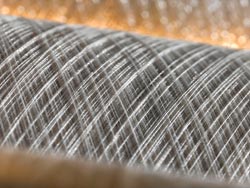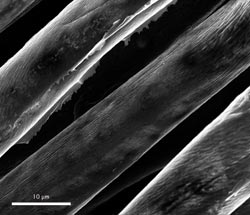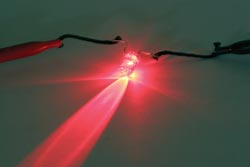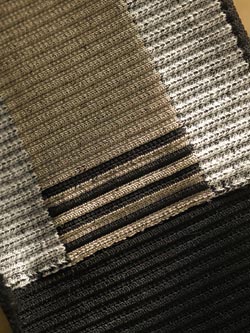Clothing serves many purposes – it keeps the wearer warm, protects skin from the sun’s damaging rays and even allows people to make a statement about who they are. Now researchers are working to make clothing even more useful by creating it from “smart fabric,” which has the potential to monitor the wearer’s health and warn of potentially dangerous situations, including injuries and the presence of allergens.

Textronics Inc. uses several fibers in the creation of its garments, one of which is this silver-coated nylon thread. Courtesy of Textronics Inc.
Smart fabrics are woven from yarn or thread that has been specially treated to conduct signals, relaying information gained from sensors integrated into the fabric and transmitting it to external monitors. Besides clothing, the fabrics eventually could be used anywhere that textiles are used today – in carpets, upholstery, sheets, curtains – the possibilities are nearly limitless.
In development
According to Nicholas A. Kotov, a professor in the chemical engineering department at the University of Michigan, Ann Arbor, other researchers have attempted to create electronic textiles using metalized and optical fibers, and some types of carbon materials, but their processes were difficult and the fabrics too uncomfortable to be used in clothing. The conductive cloth made with carbon nanotubes proved expensive to manufacture and performed only basic sensing functions; however, Kotov and his team have demonstrated that carbon nanotubes may be a reasonable solution to the problem after all.

A detailed image shows the surface of a cotton fiber coated with carbon nanotubes and anti-albumin. Courtesy of Nicolas A. Kotov.
To create their smart yarn, the researchers dipped 1.5-mm-thick cotton yarn into a solution of carbon nanotubes suspended in water and then into a sticky polymer in ethanol. They repeated the process several times and then dried the yarn. Once dry, the carbon-coated cotton can transmit enough power from a battery to power an LED. The yarn remained pliable and soft but turned black from the addition of carbon.

A carbon nanotube-coated cotton fiber connects an LED to a battery, demonstrating the conductive abilities of the smart fiber. Courtesy of Nicolas A. Kotov.
A few strands of the conductive thread, woven into traditional cotton fabric, could be used to make an inexpensive, comfortable garment with many applications. Besides powering small lights – or possibly charging electrical devices such as cell phones – the clothing could detect blood and then signal for help for an injured individual.
The investigators have tested the fiber’s ability to detect blood and discovered that, by adding the antibody anti-albumin to the carbon nanotubes solution, they could make the threads react to the presence of blood by becoming more conductive. Kotov said that this property could make the smart fabric ideal for use in uniforms for soldiers, firefighters and police officers because it could alert others of possible injury, even if the subject were unconscious.

An electrode is integrated into this fabric strap. Courtesy of Textronics Inc.
On the market
Some incarnations of smart fabrics are already on the market: Glowing clothing made from optical fibers was investigated on page 84 of the March issue of Photonics Spectra, while the October 2008 issue of BioPhotonics investigated textiles as possible pulse oximetry monitors.
Also available are garments from companies such as Textronics Inc. of Wilmington, Del., part of Adidas Corp. Textronics produces a range of clothing using conductive yarn – created with a proprietary process – that transmits signals from embedded, textile-based sensors to remote wireless receivers.
The company’s first smart textile product for consumer use was released in 2005. The device looks like any other sports bra, but the threads from which it is woven make it anything but common. The smart yarn monitors the wearer’s heart rate, transmitting the signal to a sensor integrated into the front of the garment. The sensor then relays the information to a remote device that displays the heart rate for its user.
Since the acquisition of Textronics by Adidas, the company has focused mainly on bringing smart fabrics into the consumer market for fitness and sports enthusiasts. Its current research looks to expand the range of information that can be interpreted and transmitted through the fibers. It also is looking for technology partners with commercially applicable apparel to bring to market.
Smart fabrics are developing in a multitude of forms and functions as scientists work to create clothing that will better protect and inform its wearers. Although the investigators have not yet achieved the level of integration often seen in science fiction, they are well on their way to producing clothing that truly is “smart.”